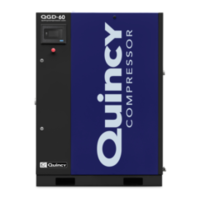Page 12
Oil and moisture residue must be drained from the air receiver daily or after each use.
Accumulations of oil residue in the receiver can be ignited by embers of carbon created
by the heat of compression - causing an explosion, damage to property and injury to
personnel.
Do not open a manual tank drain valve on any air tank containing more than 30 PSIG of air
pressure!
Never attempt to relieve an air tank by removing a pipe plug or any other system
component!
WARNING
WARNING
WARNING
Manually Draining an Air Tank:
Step 1).
Disconnect and lockout the compressor from the power source (electric models) or disconnect
the spark plug wire from the spark plug (gas engine models).
Step 2).
Tank(s) subjected to freezing temperatures may contain ice. Store the compressor in a heated
area before attempting to drain moisture from the tank(s). Reduce the air pressure in the tank
to 30 PSIG by pulling the pressure relief valve ring.
Step 3). Slowly open the drain valve and allow the moisture and air mixture to drain from the tank.
Step 4).
Once the moisture has been completely drained, close the drain valve.
Recommended Air Tank Inspection Intervals
Tank Capacity Horizontal or
Vertical
Visually Inspect Hydrostatically Inspect
80 Gal. Vertical Yearly 10 Years
60 Gal. Vertical Yearly 10 Years
30 Gal. Horizontal Yearly 10 Years
The factory recommends that all air tanks be inspected at scheduled intervals. Refer to
Recommended Air Tank Inspection Intervals Table for relative information.
Refer to federal, state or provincial, or local codes for mandatory air tank maintenance
information.
